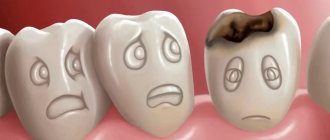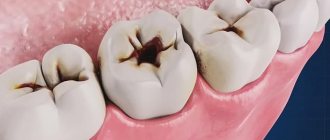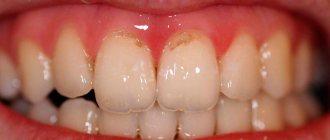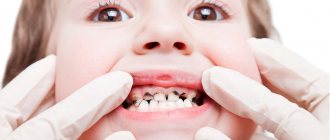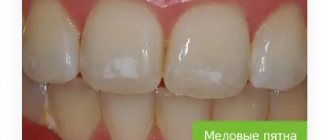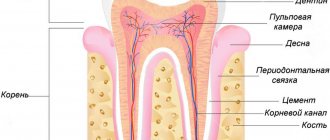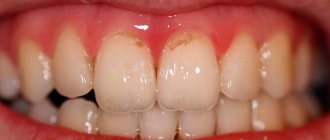Dental caries is usually classified according to different indicators. One of the most widespread is Vinogradova’s classification, according to which there are compensated, subcompensated and decompensated forms of dental caries. We will tell you more about the symptoms and treatment features of different forms of the disease in this article.
In this article
- How does dental caries occur?
- Three forms of dental caries
- Compensated form of caries
- How is compensated caries treated?
- What is subcompensated caries and what are its features?
- Features of decompensated caries
- How is decompensated caries treated?
- Pulpitis as a complication of decompensated caries
- Periodontitis with decompensated caries
- Is it possible to prevent tooth decay?
- Conclusion
How does dental caries occur?
During caries in hard dental tissues, under the influence of organic acids, first areas of enamel demineralization are formed, and then carious cavities. Acids that destroy teeth are produced by cariogenic bacteria. This occurs during the fermentation process of carbohydrates that we consume in food. According to statistics, caries is the most common dental disease; it affects the teeth of people of any age, including the development of baby teeth immediately after teething.
There are different classifications of caries, in particular the Vinogradova classification. According to this division, there are compensated, decompensated and subcompensated caries.
Bitter sweet truth
Of course, people have known for a long time that “sweets spoil teeth,” but it was possible to prove the role of diet in the occurrence of caries only when, in the course of numerous independent experiments, it was established that streptococci are present in dental plaque in people free from caries. The first step in proving the “guilt” of sugar was taken by Danish professor Frederik von der Fehr from the Royal Dental College in Aarhus. In 1970, von der Fehr conducted an experiment in which a group of volunteers with good tooth enamel completely eliminated oral hygiene - they did not brush or rinse their teeth after eating. Half of them also rinsed their mouths with a 50% sucrose solution several times a day. Lack of hygiene increased the number of bacteria in plaque, but when comparing the condition of the teeth of those who rinsed with a sweet solution with the control group, more obvious signs of caries were found - demineralization of the enamel and the appearance of stains on it.
If earlier, for example, in the not so distant 18th century, sugar was an expensive product and not everyone appeared in the diet, but now, according to dental surveys, most people in Russia and many other countries eat sweets every day. As Edith Kuzmina notes, it is not so much the amount of sweets eaten at a time that is important, but the frequency of its consumption.
Ideally, dentists advise eating sweets as little as possible and replacing fermentable sugars - glucose, sucrose and fructose - with sorbitol, mannitol and xylitol. These polyhydric alcohols have a sweet taste and are often used as sweeteners (for example, for diabetes), and carious streptococci simply cannot utilize them. Natural xylitol is found in strawberries and carrots. And if you still can’t give up sweets, then it’s better to eat them not “alone”, but together with other foods - this reduces cariogenicity. The same sour apples, for example, require copious amounts of saliva, and it dilutes and, having an alkaline reaction, partially neutralizes the acid formed in the mouth after the fermentation of sucrose and glucose.
Three forms of dental caries
Vinogradova’s classification is based on the degree of activity of dental caries:
- The compensated course of caries is characterized by the fact that the pathological process develops slowly, carious cavities are hidden under dense dentin, they are rare, and the disease progresses relatively slowly.
- The subcompensated form of the disease develops slightly faster than the compensated form. It is characterized by the appearance of dark areas on the enamel and horizontal spread without penetrating deep into the tooth.
- Decompensated caries is often multiple and spreads very quickly. With such caries, all teeth located near the cheeks are often affected.
The decompensated form is considered the most severe, in most cases accompanied by complications in the form of pulpitis or periodontitis.
Let's talk about all forms of caries in more detail.
Stages of caries development
The caries process develops sequentially in several stages:
Initial stage or caries in the white spot stage
Caries of primary teeth often begins with the appearance of white spots on the enamel. Over time, they may increase in size and change color to brown.
Superficial caries
At this stage of dental caries, the damage to the enamel is minor, but the tooth already reacts with aching pain to warm and hot food.
Average caries
A child can feel a carious cavity at the site of enamel destruction with his tongue, and parents and a doctor can see it with the naked eye. Pain when food gets on the tooth, as well as when eating hot and cold foods and drinks, increases.
Deep caries
The last stage, when not only the enamel is affected, but also the dental tissue. In the absence of treatment, inflammation of the pulp develops - pulpitis.
What types of caries are there?
fissure
caries - damage to the enamel affects special depressions on the chewing surface of the tooth - fissures.
Cervical
caries occurs in the area between the gum and the neck of the tooth, forming a kind of yellow or brown rim on the enamel.
Tooth root caries in children develops quite quickly in the absence of timely treatment of the initial forms of the disease.
Interdental
caries occurs between the lateral surfaces of adjacent teeth.
WHO (World Health Organization) offers the following classification of caries:
- enamel caries - superficial caries
- Dentin caries - spread of the inflammatory process under the enamel
- cement caries - damage to the root region of the tooth
In children, a separate classification is used - “according to Vinogradova”, on the basis of which the activity of the carious process is determined.
There is another children's classification that determines the activity of dental caries according to T.F. Vinogradova.
Based on an analysis of the number of carious teeth, the degree of their damage and the speed of development of the pathological process, Vinogradova identified three degrees of caries activity.
Compensated
This form of caries occurs in approximately half of children. The pathological process develops slowly; upon examination, isolated lesions of the teeth are detected. The enamel has a healthy shine. It is recommended for such children to visit the dentist once a year.
Subcompensated
The enamel is still shiny, but has some dull areas. As a rule, caries spreads horizontally; deep damage to the teeth is not observed.
The subcompensated form does not cause discomfort or complaints in children, but requires observation by a dentist with examinations at least once every 6 months.
Decompensated
The rarest and most severe form of caries with a high rate of development and serious complications in the form of pulpitis and periodontitis. The enamel is matte and rough, and the fissures are brown. Most often, when opening such a tooth, a carious cavity is discovered.
In case of decompensated form, the child is recommended to undergo preventive examinations at the dentist every 4 months.
Compensated form of caries
Among all the options for the course of caries, compensated is the most favorable. In this case, the pathological process is sluggish and destroys dental tissue slowly over several years. With compensated caries, remission is possible, which under certain circumstances can result in relapses. According to statistics, compensated caries develops more often than other forms.
It is characterized by smoothed symptoms:
- Acute pain is most often absent;
- the transition of carious lesions from one stage to another occurs smoothly and imperceptibly over several months or even years;
- with compensated caries, a white spot first forms on the enamel, which gradually darkens, becomes rough and less dense. At the dark spot stage, a painful reaction to temperature or taste stimuli is possible;
- The compensated form of caries is characterized by destruction of dentin while often maintaining the integrity of the tooth enamel. Therefore, the characteristic clinical picture is a carious cavity in a seemingly intact tooth crown.
How is compensated caries treated?
The method of treating compensated caries depends on the stage at which it is detected and, accordingly, on the degree of tooth destruction.
At the initial stage of a carious stain on the enamel, non-invasive methods that do not require drilling a dental crown can be effective.
- Remotherapy (remineralization).
Using special pastes, gels, and solutions, tooth enamel is saturated with calcium and fluoride ions - the main components of its mineral composition. They normalize the structure of the enamel, increase its protective properties and resistance to the corrosive effects of acid.
- Deep fluoridation.
It is similar to the remineralization procedure with the difference that the composition of medicinal preparations necessarily includes fluoride. It penetrates deep into the enamel, makes it stronger, has an antiseptic effect, and prevents the teeth from losing calcium and other minerals.
- Fissure sealing.
Fissures are natural grooves on the surface of chewing teeth. They can be of different shapes and depths, and due to their anatomical features, food debris easily accumulates in them. In addition, the enamel in the fissure area is thinner compared to other areas of the dental crown. The sealing method is often used to prevent caries in the chewing teeth of children and adults with deep grooves on their teeth. The essence of the method is that the dentist seals the natural recesses of the dental crown with a special sealant, so that food debris no longer accumulates in them and bacteria cannot multiply.
- Filling.
This method treats a compensated form of caries in the later stages, when cavities have formed in the dentin of the tooth. Most often, the dentin treatment process is painful, so the procedure is performed under local anesthesia. After the anesthetic injection takes effect, the doctor prepares the affected tooth with a drill, removes carious tissue, and then covers the cured tooth with high-quality filling material. The best treatment option is without drilling or filling. Methods of remineralization and deep fluoridation are safe, painless, and do not cause discomfort in the patient. But they are effective only at the initial stages of the carious process.
Therefore, it is important to regularly check the condition of your teeth with a dentist (for compensated forms of caries, a visit once a year is recommended) in order to notice the beginning of caries as early as possible.
Pathogenesis of caries: mechanism of disease development
Streptococci form colonies in the oral cavity - so-called dental plaques. This process goes through three stages:
- Formation of acellular organic film on the surface of the enamel - pellicles. The process takes up to several hours. The basis of the film is glycoproteins and other proteins in saliva.
- Collection of microorganisms and epithelial cells on the surface of the pellicle with subsequent growth of bacterial colonies. Continues for several days.
- Formation of mature dental plaque.
Dental plaque includes up to 70% microorganisms and has a mesh structure with semi-permeable properties. Carbohydrates easily penetrate into it and have a destructive effect on the tooth.
How does enamel destruction occur?
When eating carbohydrate foods, the microflora of the dental plaque instantly absorbs saccharides. This leads to a “metabolic explosion” and a sharp increase in acidity. After half an hour, the acidic environment is neutralized by saliva, but when carbohydrates are reintroduced, the pH level under the plaque decreases again, which leads to damage to the enamel due to increased permeability.
Against the background of the formation of organic acids on the enamel, demineralization increases, and the microspaces between the crystals of enamel prisms increase. This promotes more intensive penetration of microorganisms and their metabolic products into enamel microdefects. A cone-shaped lesion is formed, which spreads into the depths of the tooth. After some time, the surface layer of enamel dissolves - caries progresses and can lead to the removal of a baby tooth if no action is taken.
How does tooth resistance affect pathological processes?
Resistance is the ability of a tooth to withstand external influences. It depends on many factors:
- type of enamel hydroxyapatite, correctness of the protein matrix, degree of mineralization of the matrix, interaction of mineral phases and protein;
- the presence of defects in the enamel, the regularity of its structure, an electrical charge on the surface that prevents or promotes the adsorption of microorganisms;
- relief of the enamel surface, depth and shape of fissures, nature of the pellicle;
- type of structure of the skull, jaws, bite, proximity of teeth and the size of the spaces between them, etc.;
- functioning of the salivary glands;
- nutritional characteristics and somatic health.
The structure of enamel is formed at the genetic level and depends on mineralization processes.
Saliva
Saliva is the environment in which teeth are constantly present. Under favorable conditions, the processes of demineralization and remineralization occur harmoniously in it. If its composition is violated, a failure occurs. In combination with other cariogenic factors, changes in the composition of saliva provoke the formation of new lesions.
A change in the composition of saliva in an unfavorable direction occurs after taking sugar and easily digestible carbohydrates. To avoid this process, it is necessary to eliminate carbohydrates from the diet or get rid of dental plaque.
Other pathological causes contributing to the development of caries
The condition of the mother during pregnancy is of decisive importance for the health of the enamel. With toxicosis, carbohydrate metabolism disorders, gastrointestinal and thyroid diseases, chronic hypoxia, the mineralization of primary teeth in a child in the womb slows down.
Especially often, caries occurs immediately after teething in premature babies who are bottle-fed, as well as those who have suffered serious illnesses during the first year of life. The hardness of dental tissue depends on the state of the child’s digestive tract, the amount of fluoride in drinking water, and concomitant diseases during the first years of life.
Even the condition of the pulp affects the solubility of enamel. If the latter retains high functional activity, the enamel will remain hard. In turn, the condition of the pulp worsens after infectious diseases. In such children and adults, caries develops more often and more intensely, which is associated with a decrease in the immunological reactivity of the body.
What is subcompensated caries and what are its features?
Subcompensated caries occurs in approximately 25% of children with dental caries. This form is characterized by an average rate of spread of the pathological process. Characteristic features are dull enamel and superficial lesions without deep tissue involvement. Most often, subcompensated caries does not cause discomfort or pain, so it can only be detected during an examination by a dentist.
People with this form of caries are recommended to have scheduled visits to the dentist two to three times a year, as well as oral sanitation and preventive measures.
Features of decompensated caries
The decompensated form of caries is the most intensive type of development of dental disease. Decompensated caries is considered the most severe and dangerous. The first signs of the disease are rough matte enamel, darkening of the fissures; when opening the dental crown, a large carious cavity is most often discovered, and severe pain is noted when probing with a dental probe.
This form of caries develops very quickly and in most cases is accompanied by complications (tooth chipping, inflammation of adjacent tissues, complete loss), because the body cannot independently compensate for the pathological process. Against the background of the carious process, inflammation quickly penetrates into the pulp, then into the tissue surrounding the tooth. As a result, pulpitis and periodontitis occur.
How is decompensated caries treated?
If a hole has already formed in the tooth, treatment will consist of preparing the dental tissue, opening it, cleaning the carious cavity, removing the nerve if necessary, and then filling it.
The decompensated form of caries is characterized by large-scale damage to the dentition, so it is often necessary to treat several teeth at once. Or several visits are scheduled for alternate treatment. This depends on the age of the patient, the extent of the carious lesion, the need for anesthesia and a number of other factors.
After treating all teeth affected by caries, the patient is scheduled for scheduled visits to the dentist at least 3-4 times a year. Also mandatory measures for decompensated caries are recommendations on proper nutrition and oral hygiene, consultation with a doctor, ingestion of anti-caries medications, sanitation of the oral cavity, and local prevention.
Material and methods
1301 children aged 5-16 years living in Lvov were examined. Determination of the intensity and prevalence of dental caries in children was carried out according to WHO recommendations (1989). Despite WHO recommendations to study the severity of caries in permanent teeth in a key group of 12-year-old children, we expanded the scope of both the KPU index and the NIC index, studying them in all age groups for primary teeth (PD), permanent teeth (PD) and period of mixed dentition (CP+CP) with determination of the difference between the NIK of teeth and the intensity of caries [11]. A prerequisite for inclusion of patients in the study group was the written informed consent of their parents for a dental examination. All obtained data were statistically processed using the Student’s t test [5].
Pulpitis as a complication of decompensated caries
The course of caries in a decompensated form can be complicated by inflammation of the neurovascular bundle - the pulp. The inflammatory process in this area is called pulpitis. It occurs when the infection spreads beyond the tooth
The pulp contains blood vessels, nerves, and nourishes dental tissue. If it becomes inflamed, there is a risk of tooth loss due to loss of vitality. With pulpitis, the patient complains of severe, prolonged pain, which is often pulsating in nature and radiates to the temples and ears. Painful attacks are repeated with a certain frequency, last for five minutes, intensify in a supine position.
Depending on the severity and neglect of the process, pulpitis is treated with a conservative or surgical method. At an early stage, the doctor, if possible, preserves the pulp and root of the tooth, eliminating the inflammatory process with the help of medications. If the inflammation is too strong, there is a risk of it going beyond the pulp, and it is not possible to stop the pathological process with medications, in this case the doctor chooses a surgical treatment tactic, partially or completely removing the pulp. This option is less preferable, because without a neurovascular bundle, the tooth becomes virtually “dead” and serves much less time.
The complications of caries should be taken seriously and at the first symptoms, contact your dentist. If you neglect timely diagnosis and treatment, the infection can spread to other organs and tissues, which can lead to serious disruptions in the functioning of the entire body. In particular, untreated pulpitis is dangerous for the development of gumboil, periodontitis, pulp necrosis and even sepsis.
Periodontitis with decompensated caries
In addition to pulpitis, with decompensated caries another serious complication often develops - inflammation of the tissues surrounding the tooth root. This disease is called periodontitis.
The periodontium is a ligamentous apparatus that holds the tooth in the jaw and provides shock absorption. If an inflammatory process develops in the periodontal tissues, this can lead to loosening and tooth loss. Against the background of periodontitis, ulcers can form, the removal of which will require surgical opening of the gums.
Periodontal inflammation can be acute or chronic. In the first case, inflammation develops rapidly, accompanied by darkening of the tooth, acute pain, swelling of the affected tissues, and inflammation of the cheek. Chronic periodontitis is characterized by more smoothed symptoms, pain syndrome may be absent. Treatment for the chronic form is long and difficult and can take several months.
Periodontitis greatly weakens the immune system and creates a source of chronic infection in the body.
Is it possible to prevent tooth decay?
The development of any form of caries process is facilitated by a number of factors: poor diet with a large amount of carbohydrates, poor oral hygiene, insufficient intake of vitamins and minerals, rare visits to the dentist for the purposes of prevention and early diagnosis.
Addressing these risk factors helps reduce the risk of developing tooth decay or detect it at an early stage, when treatment can be as simple and effective as possible.
These preventive measures reduce the likelihood of developing any form of caries:
- Reducing the amount of carbohydrate and sweet foods in the diet, rare snacks, avoiding feeding the child at night and before bedtime. This recommendation is due to the fact that cariogenic bacteria feed primarily on carbohydrates. The longer food remains remain in the mouth, the more acid that is destructive to teeth will have time for microorganisms to produce.
- A balanced diet containing plenty of calcium, phosphorus and fluorine-containing foods. These minerals form a healthy and strong enamel structure that can resist the negative effects of cariogenic bacteria.
- Regular proper brushing of teeth using a brush, paste, floss, irrigator. Twice a year, professional teeth cleaning at the dental clinic. These measures help to get rid of dental plaque consisting of bacteria in a timely manner, and thereby reduce their negative impact on the teeth.
- Routine visit to the dentist even in the absence of complaints. With a compensated form of caries, it is recommended to visit a doctor once a year, with a subcompensated form - 2-3 times a year, with a decompensated form - 3-4 times a year. This recommendation is due to the fact that early caries often does not manifest itself with pronounced symptoms. For example, at the spot stage, the only sign of a carious lesion is whitish spots and lines on the enamel. It is quite difficult to notice them with the naked eye, but an experienced dentist will easily detect the beginning of the carious process.
If you miss the onset of the disease, a cavity forms in the tooth and complications develop. The later treatment is started, the more complex and painful it will be.
Results and discussion
It was found that the NIK index of both temporary and permanent teeth was significantly higher compared to CP, CP and CP+CP, which coincides with the results of other researchers [16, 17]. The conducted studies indicate that the highest value of the NIK index of primary teeth was found in children of 6 years of age (Fig. 1). Thus, in 6-year-old children, the NIK of primary teeth was 9.91±0.40 with an average intensity of 5.46±0.40. Up to 7 years, the intensity of caries of primary teeth and NIK decreases slightly - to 5.35±0.30 and 8.62±0.25, respectively. In children aged 8-10 years, there is a gradual decrease in the studied indicators, and at 11 and 12 years old, a significant decrease in the NIK of primary teeth was found, respectively, to 2.42 ± 0.25 and 0.68 ± 0.19, CP - to 2.58 ± 0 .24 and 0.25±0.07, which is explained by the physiological change of teeth.
Rice. 1. NIK of temporary teeth in children of Lvov.
Analysis of the indicators of the KPU and NIK of permanent teeth (Fig. 2) showed that from 6 to 7 years the KPU index increases to 0.93±0.13, and the NIK - to 2.56±0.1, which indicates intensive damage to the permanent teeth. teeth during this age period. In 8-year-old children, the NIK of permanent teeth is 2.63 ± 0.16 with KPU = 1.05 ± 0.12, in 9-year-olds - respectively 3.03 ± 0.13 and KPU = 1.44 ± 0.14. In children 10 years old, there was an increase in the NIK of permanent teeth to 4.08±0.22 and the CL - to 2.06±0.19, in children 11 and 12 years old - to 4.61±0.32 and 5.62±, respectively 0.34, KPU - up to 2.41±0.21 and 3.29±0.22, respectively. It was revealed that the NIC from 12 to 13 years of age increases from 5.94±0.32 to 7.55±0.44, and the intensity of caries of permanent teeth - from 3.54±0.20 to 4.15±0.28. In children 14 years old, the NIC of permanent teeth is 8.18±0.46 with a caries intensity of 4.65±0.31, in children 15 years old - 8.59±0.43 and 5.40±0.30, respectively. In children aged 16 years, the NIK reaches the highest value (9.40±0.36) with the NIK of permanent teeth (5.71±0.31).
Rice. 2. NIK of permanent teeth in children of Lviv.
The NIK for mixed dentition was also analyzed. In 6-year-old children, the overall NIC index is 10.39±0.40 with KPU+kp=5.78±0.30. It should be noted that from 6 to 7 years, the indices KPU + kp and the total NIK (Fig. 3) do not change significantly and are 6.28 ± 0.35 and 10.50 ± 0.30, respectively. In 8-year-old children, the NIK for KPU + CP is 9.39 ± 0.22 with an intensity of 5.48 ± 0.28, in 9-year-olds - 7.76 ± 0.33 with an intensity of 4.76 ± 0.23. In 10-year-old children, the overall NI and CP+CP remain practically unchanged and are 7.86±0.28 and 4.76±0.23, respectively. It was noted that in the age period of 11-12 years there was a decrease in both the overall NI index to 6.03 ± 0.34 and 5.94 ± 0.32, and KPU + CP - to 3.28 ± 0.21 and 3. 54±0.20.
Rice. 3. General NIK for children in Lviv.
In order to identify age groups of children for carrying out scientifically based caries preventive measures, we analyzed the NIC indicators in an age aspect. 2 peaks in the rise of NIK have been established - from 6 to 7 years and from 12 to 13 years. It is obvious that it is during these periods that a complex of factors takes place that significantly influence the caries resistance of enamel. Therefore, a more detailed study of the mechanism of their interaction and the negative impact on the hard tissues of teeth is necessary.
We analyzed the difference between the average intensity of caries and the NIC index in relative units (see table).
The difference between the average intensity of dental caries and the NIC index in children
The smallest differences in the group of primary teeth were observed in children 7-8 years old - 61.12 and 71.11%, respectively. The maximum difference was found in the group of 5-6-year-old and 10-12-year-old children. In children 5-6 years old, NIC exceeded the average intensity of caries by 92.74%, in 6 years old - by 81.50%. In the group of 10-year-old children, NIC exceeded the average intensity of caries by 2.1 times, in 11-year-old and 12-year-old children - by 2.78 and 2.72 times, respectively.
The minimum difference was established between the NIK of permanent teeth and the KPU in 15- and 16-year-old schoolchildren - 59.07 and 64.62%. At the same time, it was found that the NIK of permanent teeth in children 6-9 years old exceeded the average intensity of caries by 2.1-2.94 times, which indicates the need for a more thorough approach to preventive work, especially among children 6-7 years old. From 12 to 13 years, the difference between the NIK of permanent teeth and the KPU increases by 11.11%. These data confirm that the age groups 6–7 and 12 years are key for prevention activities.
Thus, the use of the KPU and NIC indices in combination makes it possible to assess in more detail the dental status of the oral cavity of children, which must be taken into account when developing preventive programs, a differentiated approach to treatment regimens for the category of children with multiple caries, especially for the prevention of caries of permanent teeth in children 6 -7 years.
